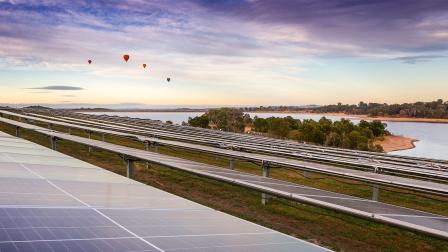A trial has shown that intermittently operating aerators at our reservoirs can achieve the same water quality outcomes as continuous aeration – while saving energy, greenhouse gas emissions, and maintenance. Read the case study to learn more.
Sustainable Development Goals:
Goal 12: Responsible consumption and production
Goal 13: Climate action
Background
We operate large aerators at our drinking water reservoirs to prevent stratification: the development of warm water layers with much colder layers below.
Historically, aerators have operated continuously throughout the warmer months (usually early November to Easter) to ensure the reservoir was well mixed. This reduces the likelihood of toxic algae blooms and ‘dirty’ water events, which can be caused by iron and manganese present in the water column.
Research focus
While aeration ensures good water quality, it is expensive to power and maintain. We undertook a trial to determine if intermittent operation of the aerators could achieve the same outcome as continuous aeration and produce good water quality – while saving on energy and maintenance.
A purpose-built 3D hydrodynamic reservoir model was developed to test a number of scenarios, ranging from continuous aerator operation, to six months of a 12-hour on/off cycle, and variations in between.
Outcomes
The model showed that running the aerator intermittently for an entire six-month period would not adequately mix the reservoir; but it did demonstrate that continuously running the aerators for three months, and then intermittently for another three months, gave the same outcome as running continuously for six months.
A live trial of this operating regime was then undertaken, which successfully maintained adequate mixing throughout the three months of intermittent operation. The trial, which utilised an automated Vertical Profiling System to sample the water, showed no stratification in the reservoir and no adverse effects on water quality. Direct power savings were estimated to be around $13,500, and maintenance and infrastructure replacement costs were reduced, as were greenhouse gas emissions.
Following the success of the trial, we will implement an automated intermittent aeration regime for at least two of Melbourne’s other reservoirs.
You may also like...
Our Path to Net Zero
We’re taking action on climate change to protect the natural resources that sustain us so Melbourne remains a great place to live.

Delivering on the Sustainable Development Goals
This report outlines Melbourne Water's unwavering commitment to advancing sustainability through the United Nations Sustainable Development Goals (SDGs).



